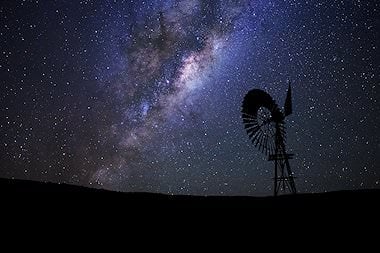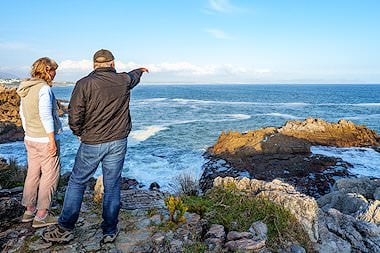South Africa's Agulhas National Park
Help Me Plan- Home
- >
- African Travel
- >
- South Africa
- >
- National Parks
- >
- Agulhas National Park
Agulhas National Park Destination Guide
Agulhas National Park protects Africa’s southernmost tip where the Atlantic and Indian oceans officially meet. The coastline, fynbos and wetlands host rare plants, prolific birdlife and historic shipwrecks. Highlights include the 1848 Cape Agulhas Lighthouse, the Meisho Maru 38 wreck, and trails across the Agulhas Plain with sweeping ocean views.
Getting There
By Air: The Agulhas National Park is flanked to the west by Cape Town International Airport (about three hours) and to the east by George International Airport (about three and a half hours) situated on the Garden Route. The airport of choice will depend on your tour preference.
By Road: Your guide will transport you in a private, air-conditioned vehicle across the scenic Overberg region from Cape Town or the agricultural plains stretching from George. The drive takes approximately three hours from Cape Town International Airport and three and a half hours from George.
Weather & Best Time To Visit
The Overberg region, specifically Cape Agulhas, has a consistently mild climate, with mostly hot and dry summers followed by cool, rainy winters. The region is characterized by south-easterly or north-westerly winds throughout the year, which helped earn the area the name “the Cape of Storms.”
It is best to visit the park between August and April, in the late winter to summer, as the flora begins to bloom. At this time, southern right whale are recurrent in the waters just off the Agulhas Plains, and migratory bird return for their annual southern migration.

The Agulhas Lighthouse is the oldest working lighthouse in Southern Africa, built in 1848, following the design of the Pharos of Alexandria in Egypt. It fell into disuse but was restored and reopened in March 1988. Today its 7.5-million-candlepower lamp is visible for 30 nautical miles.
Safaris and Tours that visit Agulhas
Stargazing in the Karoo, whale watching, wine routes, and safari excursions are also part of the experiences you can enjoy while touring South Africa.
Visit the vibrant city of Cape Town before traveling on to first Agulhas and then the Garden Route for coastal-oriented activities before a safari in the Addo Elephant National Park.
This tour focuses on stargazing in the southern part of South Africa and visits the Boland, Karoo, and Overberg regions, where guests overnight at De Hoop near Agulhas.
On this tour, visits are made to Franschhoek in the Cape Winelands before exploring South Africa's whale coast from bases at Hermanus and Arniston near Agulhas.
Reasons to visit Agulhas National Park
History
Nestled in the Agulhas Plain, the national park conserves not only the endangered lowland fynbos but a graveyard of ships that met their end in the geographically extreme waters where the Indian and Atlantic oceans meet. Known as the Cape of Needles or the Ship's Graveyard, it is estimated that 150 wrecks litter the ocean floor.
The Lighthouse
A short kilometer east of the southernmost tip of the African continent, you'll find the second-oldest lighthouse in South Africa, built in 1848. The lighthouse, modeled after the Pharos of Alexandria, casts a beam seen 50 km out to sea. This national monument is a must-see.
Biodiversity
Of the world's six plant kingdoms, the Cape Floral Kingdom is renowned for being the smallest and richest in diversity. Agulhas National Park boasts an estimated 2,000 species of indigenous plants, of which about 100 are endemic to the area, and over 100 are listed in the Red Data Book. Its biodiverse qualities compare to those of tropical rainforests.
Experiences to Savor at Agulhas National Park
When visiting Agulhas National Park in South Africa, you'll savor the site's storied history and geographical significance. Moreover, the location offers wide coastal views and memorable sunsets.
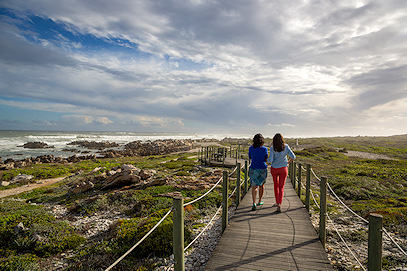
Journey through time
Hiking along signed trails, tracing the outline of shipwrecks, or walking from the lighthouse to the marker that indicates the official dividing line between the Atlantic and Indian oceans offers a vivid sense of maritime history.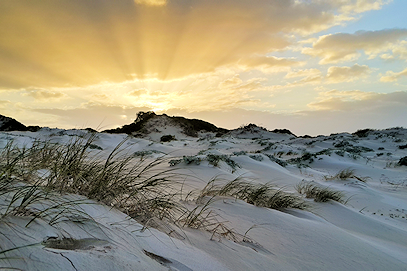
Southern sunsets
Watch the sun set across the white dunes at the southernmost tip of Africa. This is also a place to look for southern right whale in season and, at times, passing dolphin and seal.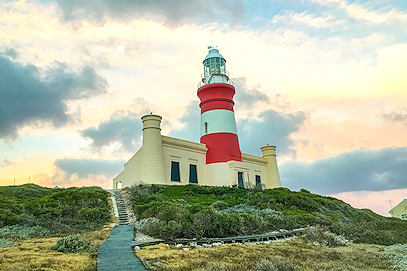
Following the light
The Agulhas Lighthouse, built to reduce shipwrecks along this coast, tells the story of Cabo dos Agulhas (Cape of Needles) and centuries of navigation at the southern tip of Africa.Useful Information
History
The region's cultural history spans millennia, as remnants from earlier eras still wash onto the shores. Cabo dos Agulhas, named by Bartholomew Dias, translates to the Cape of Needles. Shipwrecks litter the coastline and endow the coastal town with a rich heritage, as some shipwreck survivors ultimately settled here.
The area was named not only for its sharp reefs and coastline but also because the ships that reached the point experienced compass needles swinging, unable to determine true north from magnetic north. The coastline is littered with shipwrecks, which have endowed the coastal town with a rich heritage.
Many buildings in the area, including historic homes and the Water Mill in Elim, were built with debris from ships that washed ashore. The Meisho Maru 38 ran aground in 1982; all 17 crew survived.
Wildlife
A diversity of habitats—including wetlands, a salt pan, and fynbos—attract bird in multitudes. Species include the endangered African black oystercatcher with a current population of fewer than 5,000 adults and the near-threatened Damara tern. Other notable species include Cape clapper lark, blue crane, black harrier, black eagle and flamingo. About 270 identified species visit the area.
Mammal and reptile in the park include chacma baboon, bushbuck, klipspringer, ostrich, tortoise, porcupine and snake. With luck, you might see Cape fox, honey badger, or the endangered Cape frog. Additionally, southern right whale frequent the area to mate and give birth and are often joined by dolphin and seal. The abundant waters make this coastline one of South Africa’s notable fishing grounds.
Vegetation & Terrain
Once covered in highly endangered lowland fynbos and renosterveld, the park conserves and extends the Cape Floral Kingdom and its rich flora and fauna. Agulhas National Park boasts an estimated 2,000 indigenous plant species, of which about 100 are endemic to the area, and over 100 are listed in the Red Data Book.
The plan to expand around Cape Agulhas has been successful, growing from 4 hectares at proclamation in 1998 to approximately 22,000 hectares at present. Future conservation aims include widening corridors and restoring ecological processes across the Agulhas Plain.
Activities
Visit the Agulhas Lighthouse museum and the shipwrecks along the coastline. Explore local heritage linked to the Khoi, and walk trails like Spookdraai (Ghost-turn) and Rasperpunt, which weave history and coastal scenery. Be sure to stand at the southern tip of Africa and enjoy wide beaches where you may spot whale, dolphin and seal offshore in season.


